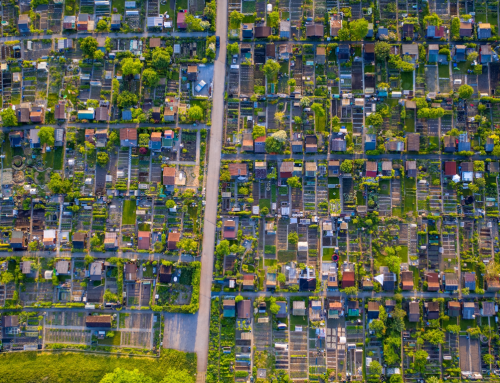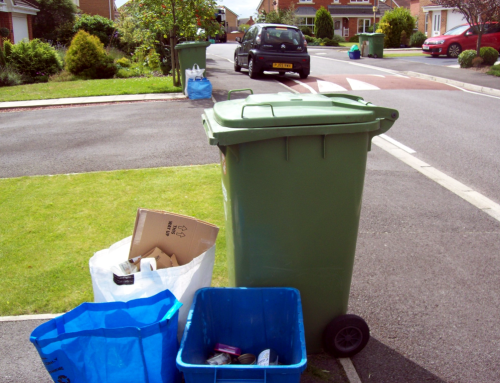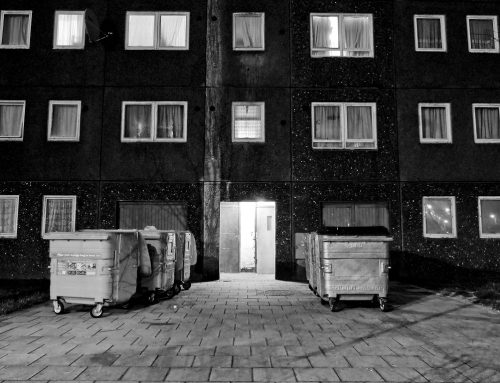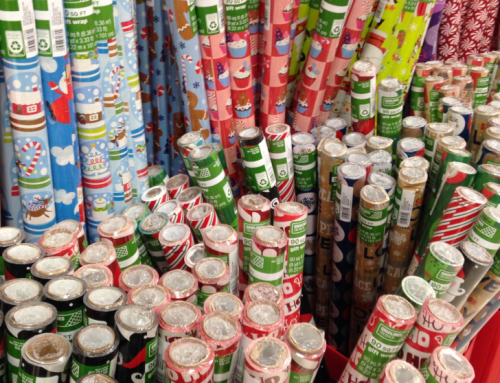I was recently speaking to my son’s great-grandmother about her experience of using nappies when her children were in diapers fifty-something years ago. She simply shrugged her shoulders and said, “Well, I was one of the lucky ones — I had a washing machine by the time the first one arrived.”
One of the lucky ones?! Nowadays most parents count themselves lucky because they don’t have to use reusable nappies at all! When it came to deciding upon a method for capturing and managing the daily discharges of my own new-born son, I was certainly not considering hand washing his diapers. It didn’t even cross my mind. For me, as I guess it is for most environmentally minded individuals in the 21st century, it was about disposable vs. reusable nappies.
If I did not have access to a washing machine the choice would have been easy: it would have been disposables for sure! However, as a washing machine-owning environmental consultant, with a particular interest in waste prevention, I had to give the whole subject a bit more thought.
Weighing up the carbon
Some years ago the UK’s Environment Agency published a comprehensive life cycle assessment of the environmental impacts of disposable and reusable nappies. This study found that reusable nappies only outperformed their competitors when managed under certain quite specific conditions; for example, washing at 60oC in A-rated washing machines, and minimising the use of tumble driers. Coming to the subject for the first time I was left feeling that the case for real nappies might not be as strong as I’d been led to believe.
The evidence seemed to suggest that disposable nappies might be the way to go: not only would I be spared the burden of domestic slavery, but the environmental implications of my choice were marginal. Luckily, despite – or because of – my uncertainty, I decided to ‘go real’ and I soon realised that (thanks be to modern appliances) washing and managing reusable nappies is really not that much of a burden.
I also found that, in practice, many of the ways of reducing the carbon impact of reusable nappies suggested by the Environment Agency’s study could quite easily be achieved. The report suggests:
- Line drying outside whenever possible;
- Tumble drying as little as possible;
- Not washing above 60°C;
- Washing fuller loads;
- When replacing appliances, choosing more energy efficient models (A+ rated machines are preferred); and
- Reusing nappies if you have another child.
None of this is rocket science and can quite easily be achieved with a little forethought. For example, I purchased my son’s nappies second hand on eBay; we seldom, if ever, wash the nappies at or above 60oC; and as far as possible — given the UK’s unpredictable weather — we dry the nappies outside. The Agency’s assessment suggests that the global warming impact of reusables can be reduced by up to 40% under these circumstances, making the case for them a lot stronger.
Weighing up the costs
If the environmental case for switching to real nappies fails to convince some, what about the financial case? According to research published by the Waste & Resources Action Programme (WRAP), a child will, on average, use five nappies a day during the approximately two and a half years before they are potty-trained. Assuming a cost of £10 for a pack of 50 mid-to-upper range nappies, this equates to £912 over 30 months, compared to approximately £80 to £250 for the one-off purchase of a set of reusable nappies. According to Go Real the cost of washing nappies is approximately £1 per week, or £130 over two and a half years. Thus, the personal savings associated with using reusable nappies could amount to anywhere between £530 and £700 per child, leaving aside the fact that you do not need to buy a new set if you have a second child.
There is also a convincing argument for reusable nappies when it comes to public finances. Recently I developed a waste prevention model to help local authorities to assess the environmental and financial benefits of various waste prevention initiatives, one of which was promoting reusable nappies. The work highlighted that if in any given year 1,000 families started using real nappies from the third month onwards, on a conservative calculation this could avoid 1,032 tonnes of waste over a two and a half year period.[1] Much of this waste is landfilled. Landfill tax will be £80 per tonne next year, while the median gate fee charged at landfill sites is around £21 per tonne, making the total avoided cost to the council £104,232.
My colleague Chris Sherrington has argued that the introduction of Pay as You Throw schemes would align the financial interests of householders and the local council; it could certainly incentivise more parents to choose the reuseable nappy option. Given the financial difficulties faced by local authorities across the country, and the extensive cuts that are being made to vital public services, is there not a moral as well as an economic case for collective action to switch to reusable nappies? Just think what public services could be saved if many thousands of families started using reusable nappies. How many libraries or youth clubs could stay open? How much additional care could be provided for elderly people?
Let’s go real
There are many good websites, Go Real being one, which offer advice to parents grappling with this choice, including signposting which local authorities provide subsidies to encourage families to use reusable nappies. Adding these incentives to the financial case I’ve outlined for reusables makes a strong case for cash-strapped parents to consider. Those who go real will save their own cash, cut costs for the council and reduce greenhouse gas emissions.
It is estimated that 3 billion nappies are discarded in the UK each year. In a world of modern appliances, and with the advances that have been made in the design and usability of reusable nappies, the barriers to going real are lower than ever, while the argument in favour is stronger. Let’s take up the challenge and get washing!
[1] These calculations are based on WRAP research into the average weight and frequency of nappy usage for each six month period between 0 and 2.5 years. In addition, it has been assumed that: 10% of households stop using nappies after each six month period (i.e. only 656 of the 1,000 children are still in reusable nappies at two and a half years of age); and reusable nappies are only used 80% of the time (e.g. disposables are used at night or when away on holiday). If these last two assumptions are not made the tonnage prevented would be a lot higher –1,626 tonnes for the 2.5 years, with a total avoided landfill cost of £164,226.







The Dutch government promises to investigate environment-friendly ways of recycling diapers in a circular economy. Studies show that 5.4% of household waste in the Netherlands consists of diapers and incontinent material for adults. Read more http://nos.nl/artikel/659281-onderzoek-naar-recyclen-luiers.html
Reusables are great (from env and econ perspectives) and we used them for a year or so, but then our boy started to get nappy rash, and although i loathe the waste from disposables, the technology is such that he gets no rash with them…a conundrum, but we’re back filling our residual waste bin with smelly nappies, which makes me sad, but his bottom happier. Reusables should always be tried first though, as i think most kids are fine with them.
I think the used reusable nappies is a good job. in this way i am not trying to save money which spend by buying new nappies. The point is one is useable then use it why are you throw it in the basket. I am using reusable nappies for my 3 child which are no 4 to 5 year. I like that post.
a fantastic read, have posted a link on the go real facebook page!
I have used reusable nappies since my daughter was 6wks old and she is now nearly 22months old. 90% of our nappies are preloved either from ebay or facebook groups so have saved me a huge amount of money. We wash our nappies every 3-4 days, dry outside when possible, I don’t own a tumble dryer and always wash at 60degrees or below. Even my husband has mastered putting the most complicated nappies on our daughter. I also run a cloth nappy library for my local area and although i only opened in April 2013 i have helped 7 women change from disposable nappies to reusables..
Hi Sue, very interested to read your response to this thread. Out of interest was just wondering which area/county you live in? Guessing that you saw this article on the Go Real website? (as I asked them to comment on the original thread). As a Local Authority we try so hard to maintain funding to continue to promote real nappies, but because we have difficulties to prove how many parents actually do convert over to using real nappies, makes it difficult to prove our campaigning provides value for money. I am HOPING you might live in Surrey….but never mind if you don’t!
From what I can see, the development of the nappy has paralleled other technological advances and we have moved far beyond the square piece of toweling that constituted a nappy even 30 years ago. The nappy pin seems also to be a thing of the past.
Parents have never had it so good. Even I might be persuaded to sire a child under these conditions.
I was lucky enough to be able to borrow some reusable nappies from a friend. I used them from when my daughter was about 4 months old. However my husband refused to use them and my mum struggled with them (even though she used reusables when I was a nipper!). No other babies at my daughter’s nursery were in reusables so I used them at home 3-4 days per week and she was in disposables 3 days at nursery and overnight. Every time I used one I thought of the money I saved and the reduction in waste. We live in a flat with no tumble dryer and I washed at low temperatures as much as possible. It was definitely manageable.
However, at about 20 months she refused to let me put them on her any more! I guess they were bulky and a bit tight – even though I had the appropriate ones for her size/weight. It depresses me whenever I put our waste out now as it’s more than double what it used to be. Can’t wait for potty training!
Hi, why did you not take it as a sign that she is ready for potty? My two girls were both out of reusables by 20 months!! with no problem whatsover.
For some light ‘bed time'(!) reading, the Local Government Association has prepared a Waste Review. There is no specific reference to nappies but definitely an interesting push towards ‘reuse’.
http://www.local.gov.uk/c/document_library/get_file?uuid=280bbfdf-ac07-43c3-96aa-64a098d1b96d&groupId=10171
Interesting article following the Waste review:
http://www.letsrecycle.com/news/latest-news/waste-management/minister-2018disappointed2019-by-local-waste-review-focus
Great article Thomas, both our kids (now 10 and 7)used cotton nappies. On first we made use of our regional nappy laundry service which was run as a labour of love by Natalie Sargant and then co-operative business with help from Sustainable Wales. In recent years at la level I sense a certain fatigue towards the real nappy campaign. Perhaps its down to lack of resources in waste teams but like JR I am pleased you are giving the subject a much needed airing and I think that your article will help to reinforce their relevance in waste circles at least.
Very pleased to see this favorite subject of mine given an airing (pun intended). My set of terry nappies were still going strong after 3 sons had grown out of them – and the washing machine went on for another 8 years (14 years of service in total). LCA studies always seem to take too narrow a view. Possibly because they assume the washing machine and nappies will be disposed of after the baby finishes using the nappies? The throw away mentality is very deeply engrained!
I do think the money saving of the councils is often overlooked by people, and yes it would be socially responsible for more to use cloth. Just think of the schemes to encourage recycling and compare them to the schemes (or lack of) for people to use cloth nappies.
To me the washing etc is no less of a hassle than realising I have run out and needing to run to the shops, or emptying the bin every day of stinky nappies – its only chucking them into the wash, hardly takes a minute!
Thanks all for the comments – good to see some committed souls out there!
I agree with Phillip, there are a number of behavioural and practical barriers that can discourage families from using reusable nappies. People should definitely not be made to feel guilty about not using reusable nappies, and a fine line needs to be tread when undertaking public campaigns to ensure that this does not happen. The truth is that disposable nappies can be a life saver and I definably also make use of them at home!
That said, one thing that is of interest to me is the fact that our perception of barriers are continually shifting: the introduction of disposable nappies suddenly means that a number of ‘barriers’ are created which makes reusable nappies less preferable. Is this right? Unavoidable? A similar shift has occurred with air conditioning. Where once it was a luxury, it is now considered normal, and as a consequence our reported levels of discomfort when temperatures fluctuate too much have increased substantially.
Putting all talk of personal responsibilities aside, I really like Phillip’s suggestion of introducing a producer responsibility scheme for nappies. This would see nappy producers helping to fit some of the costs which are currently being passed on to society and the environment. Just imagine if they started taking responsibility for the full life cycle of their products? Maybe the discussion should be less about how we all need to change our behaviour and more about how companies can change theirs?
My daughter has used cloth nappies since she was 6wks old, she is now nearly 18months old and we have had one bought of nappy rash in that time. 90% of our stash of reusable nappies are preloved ie ebay, facebook groups and friends.
I have also recently started the facebook page for advice on cloth nappies and i am starting my own library in the area too so parents can come and try nappies, before they spend money on nappies that maybe don’t suit their baby.
There are many local councils still running schemes, many run cloth nappy trials or incentives.
A full list of participating councils, nappy information and advice and importantly where to buy your nappies can be found at -www.greatbritishnappyhunt.co.uk
It’s easy when you know how!
Did you know there is a huge network of cloth nappy libraries in the UK? They are mostly non-profit, run by volunteers – people can try cloth before they go out and invest money, thus finding what is right for them. https://maps.google.com/maps/ms?msid=210790892075311005303.0004c9cf0c87b3ebc4c89&msa=0
Classic Daily Mail reportage:
http://www.dailymail.co.uk/news/article-2337312/Mother-refused-larger-wheelie-bin-admitting-using-DISPOSABLE-NAPPIES-babies.html
Thank you for drawing attention to Go Real! It is a really useful portal. Your article has raised some great points.
Phillip is right – Real Nappies do offer parents an alternative choice to disposables and Go Real works hard to furnish parents with all the information and support they need to make an informed decision. Our advice line is specifically there so that parents don’t ‘throw in the towel’ at the first leak.
From experience, we tend to distance ourselves from the emotional blackmail, and say every Real Nappy used is one less disposable in landfill….if you can use them full time, that’s fantastic!
For some parents, it’s easy – a case of ‘mind over matter’ and just get into a routine. Afterall, we do have it easy these days compared with ‘pre-washing-machine-days’.
For other parents, it’s just not for them. Life is too short and pushing the point only ostracizes them …or worse, makes them feel ‘guilty’. That’s not what Go Real is here for.
Go Real works closely with Local Authorities to help them run initiatives or incentives. In particular Surrey Council and Cheshire West and Chester Council offer parents the opportunity to borrow a FREE Trial Kit for a period of 3 weeks – the goal being to help parents discover what it entails and decipher which nappy is best suited to them, their baby and their circumstances.
http://www.goreal.org.uk/surrey
http://www.goreal.org.uk/westcheshire
These days, Real Nappies are more regularly spotted in some participating Surrey Children’s Centre playgroups than in any part of the country!
These are templates of schemes that do work and all Local Authorities would do well to look at developing similar schemes – to effectively reduce their waste costs and encourage the next generation to rethink their whole attitude towards waste. It’s a frame of mind – think ‘Minimisation’ as the next rung up from ‘Recycling’.
If we can nurture attitudes and encourage a volte-face on our disposable culture, who knows…. maybe in 2-3 generations down the line, Real Nappies might become the norm.
Hi Phillip – I’m glad you brought up the link to the recent developments with Knowaste. Their decision to close down their current UK plant is really discouraging, especially for those authorities that have put in place collection services for sanitary products. It looks as though there may be some new entrants to the market later this year – but it is another case where the development of collection and reprocessing need to move hand in hand. Perhaps there might be scope for authorities to work together to agree to implement a collection scheme, with sufficient lead time so that a facility could be built to deal with the waste?
Clearly, there will be times when disposable products are the most practical, and I get the sense that once this gets started as a separate waste stream, it could rapidly become commonplace across the UK.
All good arguments, but unfortunately ones that have been made before by campaigners and real nappy businesses. The EA/ERM LCA study did not help – even though it did show that used properly real nappies are significantly better in global warming terms, the report headline was more equivocal (although not as bad as the EA’s first attempt).
In my time running the WRAP Real Nappy Campaign. I talked to a lot of parents about the choice and there are other behavioural barriers to overcome. While a lot of young parents are concerned about the environment – convenience is more pressing for them. Washing nappies may not be that difficult – especially if you do have reliable outdoor drying space – but many don’t. Washing is certainly perceived as a problem – and drying definitely is. Convenience also extends to use away from home – where a disposable is seen by many to be preferable. And many nurseries will only use disposables.
Part of the answer is not to be absolutist but to make it clear that it is OK for parents to use which ever is best suited to the circumstances without feeling guilty.
Disposable nappies ( and incontinence products for adults) do impose costs on the rest of us but they are often used as an argument against PAYT (punishing struggling parents and the infirm). An alternative would be to introduce a producer responsibility regime for these products and put the might of Proctor and Gamble behind efforts to recover and recycle the products. The Experience of Knowaste – here and in Europe – shows that something more is needed than a single company trying to develop a solution which so far they have failed to sustain.